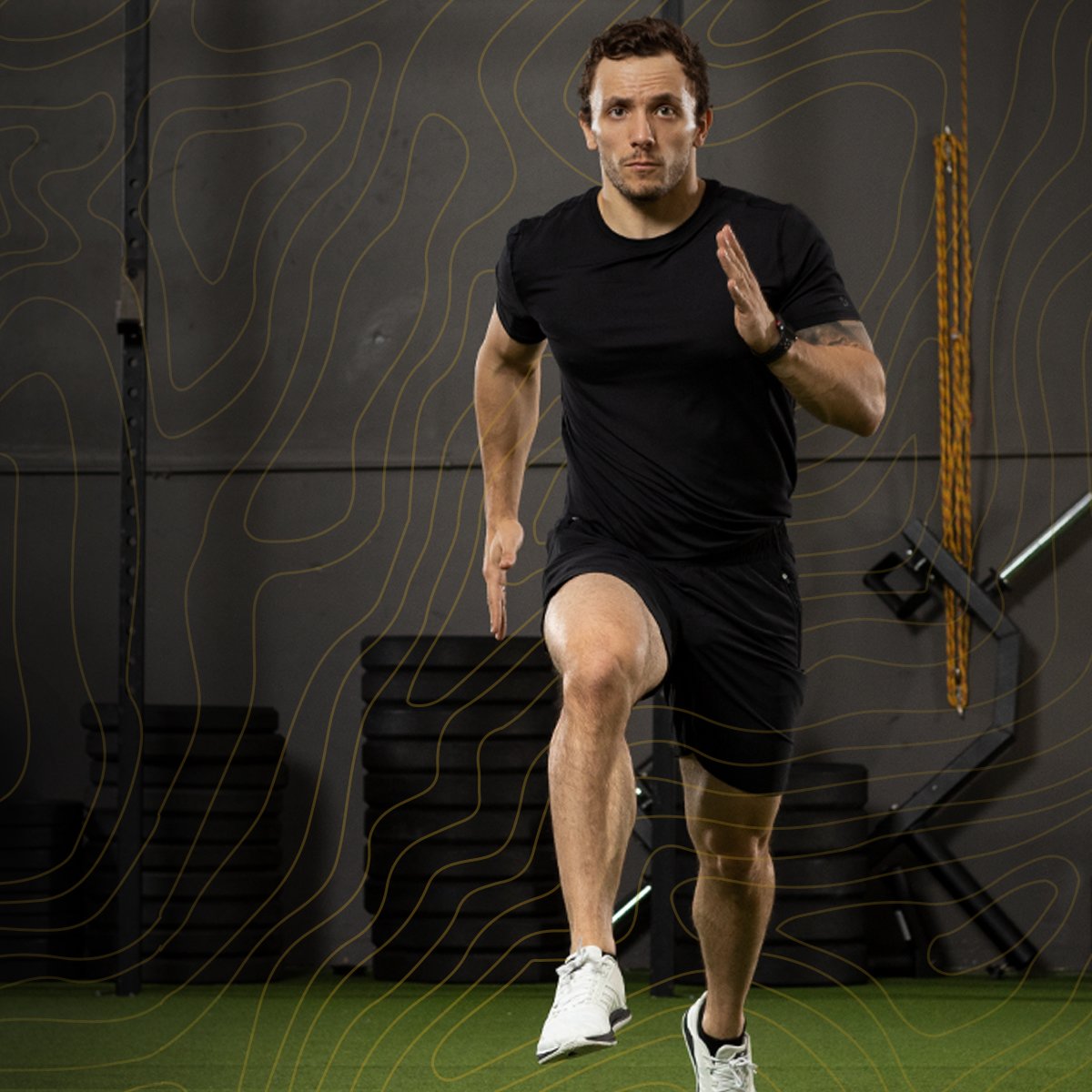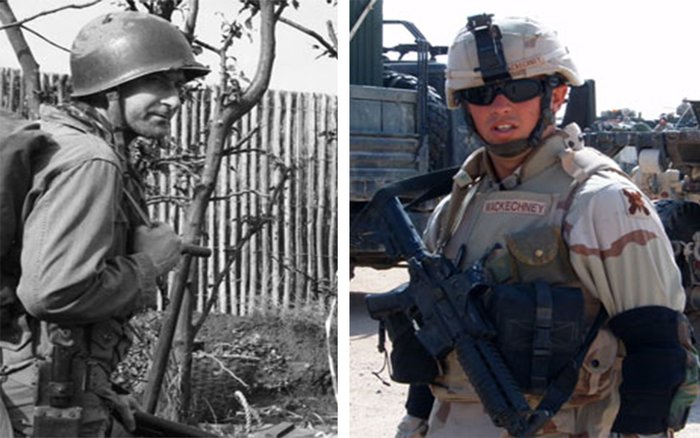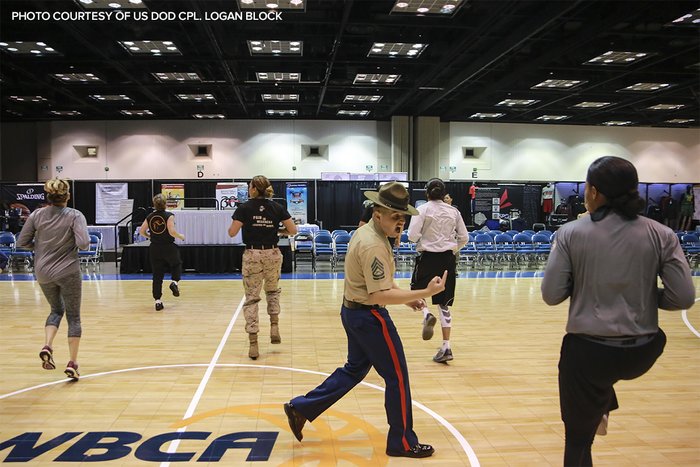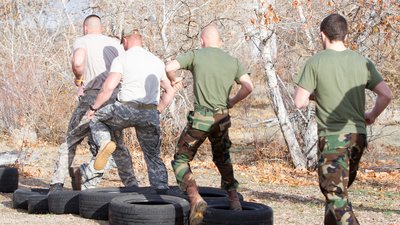Through the years, the approach to physical training within the military has evolved to coincide with the tactical requirements of the role of the modern day soldier. When I first joined the Army back in 1997, it was a different Army than the one in which my father, his father before him, and his father before him all had enlisted.
And what's more, it's still changing all the time. Most recently, the US Army decided to abandon its old physical fitness test, which consisted of:
- Max push-ups in 2 min.
- Max sit-ups in 2 min.
- 2-mile run, for time
The new test, known as the Army Combat Fitness Test, or ACFT, consists of six events:
- 3-rep max trap bar deadlift, using low handles
- Medicine ball power throw with a 10-lb. ball
- Max hand-release push-ups in 2 min.
- A sprint-drag-carry medley using sleds and kettlebells
- Max hanging leg tucks in 2 min.
- 2-mile run, for time
This new test is no joke, even for people with extensive training backgrounds. To prepare for it, use Bodybuilding.com's new program Combat Fit: 8-Week ACFT Training Plan.

My military story
I come from a long line of military men, all of whom have served in combat missions throughout different generations. My great grandfather served in both the Boer War in South Africa and the Great War, also known as World War I; he even received medals for valor. My grandfather served in WWII, Congo and Cypress during the Turkish/Greek War, and my father served in Lebanon during the Israeli invasion in 1982 as well as several missions at home during the troubles. Like my father, I also served in Lebanon and home.
My father was a military PTI (Physical Training Instructor) and was responsible for the physical training of our home brigade. He also trained several of Ireland's elite Special Forces which are called Rangers (In Irish we call them Fianóglac pronounced—fi anne og lock). I remember when I had to do my fitness test to be accepted into the Army, I had to travel to another barracks to ensure that all of the instructors would be impartial. I was fit and strong. I had been bodybuilding for almost 4 years at that stage.

I remember completing the final phase of the fitness test, a 2-mile run where I was behind two other guys and a girl. As I ran I heard commands from the old man, "You'd better get the lead out of your arse or you're walking back to Limerick," which was a mere 60 miles away. The messages were relayed via the PTIs overseeing the tests "Young Bullman, you don't wanna piss him off, he's not joking!" I got a surge of adrenalin and ran my arse off, coming in only behind the woman, who I later learned was an international cross country runner.
As my army career progressed I learned from the advice of my father, Sgt. Mick Bullman, Retired. Since I too wanted to progress and become a PTI (and I prided myself at being the fittest man in the unit) I wanted more out of my training.
I not only wanted to be fit for my job as an infantry man, reconnaissance platoon, but also to progress so one day I could be a Ranger. Each specific job in the military requires a different approach to physical training. Each job has various physical demands. Each individual has to maintain a certain level of physical fitness, but a recon platoon must be more fit and stronger than a cavalry operative, and a Ranger must outshine everyone; his job is far more demanding, both physically and mentally.
How to Prepare for A Traditional Military Fitness Test
Below I have outlined a typical 6-week program suitable for a Special Forces operative, or anyone who has to pass a test built around push-ups, pull-ups, running, and carrying a pack. The new ACFT, as mentioned earlier, demands its own specific training approach, like the Combat Fit plan.

Different Special Forces units will also have different fitness requirements. For example, the training program below is suitable for Army Rangers, Force Recon and the British SAS Regimen. Those units are required to maintain outstanding levels of fitness and hiking massive distances carrying heavy weight is not uncommon.
Week 1
Note: Only intense workout days are listed here. Do weight training or swimming workouts on your "easy" days.
Day 1
Fitness Test
- Sit and reach flexibility test.
- Push-ups: Maximum in 60 seconds
- Sit-ups: Maximum in 60 seconds
- Pull-ups: Maximum in 60 seconds
- Run: 2 miles as fast as possible
- Swim: 100 meter nonstop using any stroke, without touching the side or bottom of the pool.
- Forced march with 30-pound rucksack: While carrying 30 pounds in a backpack, walk 3 miles in 45 minutes on a road or 1 hour if walking cross-country. Wear well broken-in boots with thick socks.
Day 2
- Push-ups: 3 sets of maximum in 30 seconds
- Run: 3 miles at moderate 8-9 minute mile pace
- Rope climb or pull-ups: 3 sets to failure
- Forced march with 30-pound rucksack: While carrying 30 pounds in a backpack, walk 5 miles in 1 hour and 15 minutes on a road or 1 hour and 40 minutes if walking cross-country.
Day 3
- Forced march with 30-pound rucksack: 5 miles in 1 hour and 15 minutes (along the road) or 1 hour and 40 minutes (cross-country).

{{caption}}
Week 2
Day 1
- Forced march with 30-pound rucksack: 5 miles in 1 hour and 15 minutes (along the road) or 1 hour and 40 minutes (cross-country).
Day 2
- Push-ups: 3 sets of maximum in 35 seconds
- Pull-ups: 3 sets of maximum in 35 seconds
- Sit-ups: 3 sets of maximum in 35 seconds
- Run: 5 miles at moderate 8 to 9 minute mile pace
- Squats: 3 sets of 50 reps with 35 pound rucksack
Day 3
- Forced march with 35-pound rucksack: 10 miles in 3 hours (along a road) or 4 hours (cross-country).
Week 3
Day 1
- Push-ups: 4 sets of maximum in 40 seconds
- Pull-ups: 4 sets of maximum in 40 seconds
- Sit-ups: 4 sets of maximum in 40 seconds
- Run: 4 miles at moderate to fast 7 to 8 minute mile pace
- Squats: 4 sets of 50 reps with 40 pound rucksack
Day 2
- Forced march with 40-pound rucksack: 12 miles in 4 hours (along a road) or 4 hours and 40 minutes (cross-country).
Day 3
- Push-ups: 4 sets of maximum in 45 seconds
- Pull-ups: 4 sets of maximum in 45 seconds
- Sit-ups: 4 sets of maximum in 45 seconds
- Run: 6 miles at moderate to fast 7 to 8 minute mile pace
- Squats: 4 sets of 50 reps with 40 pound rucksack
Week 4
Day 1
- Forced march with a 50-pound rucksack: 14 miles in 4 hours (along a road) or 4 hours and 40 minutes (cross-country).
Day 2
- Push-ups: 4 sets of maximum in 60 seconds
- Pull-ups: 4 sets of maximum in 60 seconds
- Sit-ups: 4 sets of maximum in 60 seconds
- Run: 6 miles at moderate to fast 7 to 8 minute mile pace
- Squats: 4 sets of 50 reps with 50 pound rucksack
Day 3
- Forced march with a 50-pound rucksack: 18 miles in 4 hours and 45 minutes (along a road) or 6 hours (cross-country).
Week 5
Day 1
- Run: 3 miles at a fast 6-7 minute mile pace.
- Swim: 500 meters nonstop swim, using any stroke but backstroke.
Day 2
Fitness Test
- Sit and reach flexibility test.
- Push-ups: Maximum in 60 seconds
- Sit-ups: Maximum in 60 seconds
- Pull-ups: Maximum in 60 seconds
- Run: 2 miles as fast as possible
Day 3
- Forced march with a 50-pound rucksack: 18 miles in 4 hours and 30 minutes (along a road) or 6 hours (cross-country).
Don't Be Unprepared on Test Day!
Although the above program is typical of any elite Special Forces Operative around the world, the distance and weight being used are not for the untrained individual, and the word "elite" cannot be emphasized enough. Never run with weight on your back; the chance of suffering an injury is huge. Always be sure to wear good boots when hiking.
I use Mendels, which have a carbon fiber plate in the sole for ultimate support. So now you know what it takes physically to be as strong as a Special Forces Operative, but are you brave enough to attempt the workout? Have you got what it takes?
Remember, only the strong survive and to the brave and the faithful, nothing is impossible.

